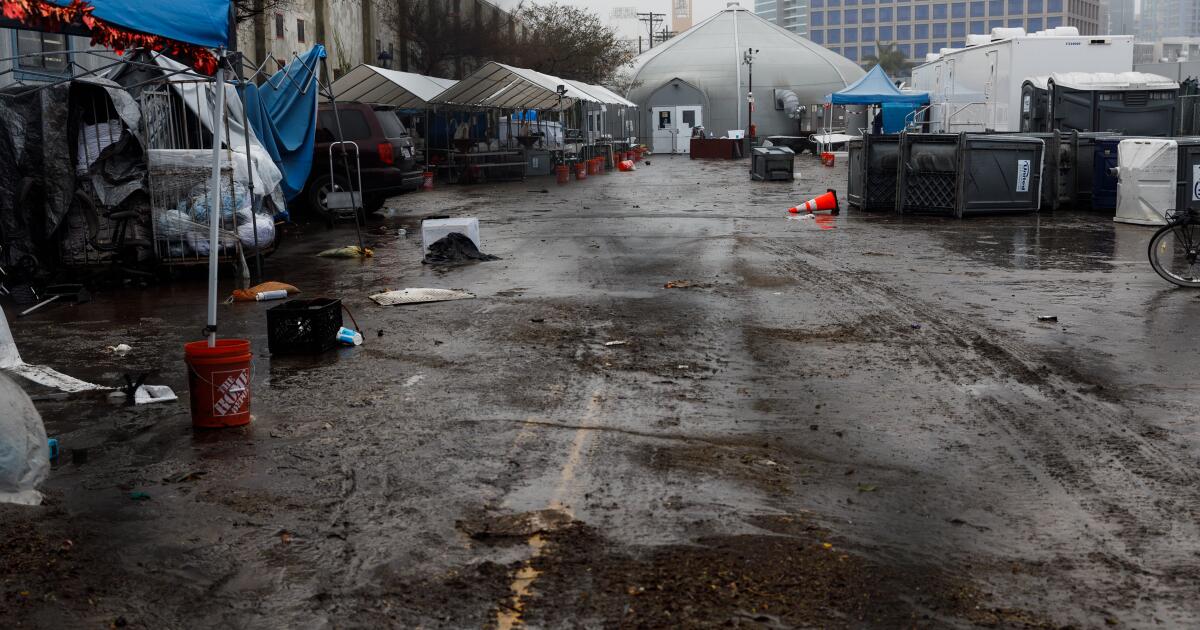
Jonathan Mbadinuju has had a rough few months.
Last year, the 32-year-old said he fled his native Nigeria. Mbadinuju spent weeks walking through Central America (and was separated from his brother in Panama) before finally requesting asylum at the U.S.-Mexico border in July.
But standing downtown Monday, outside a large tent shelter where he’d been staying, felt like a particularly low moment. Flooding had forced Mbadinuju and hundreds of others from their bunks and now he wasn’t sure if his passport was still inside. Or his laptop. Or the money he’d been saving for a lawyer.
“At least we got life,” he said.
Monday’s historic rainfall fell hard on the thousands of people who live on San Diego streets as well as hundreds of residents at two shelter sites. Around 160 had to leave the city’s first designated camping area while more than 320 escaped the Alpha Project tent which may be damaged beyond repair.
Both locations have been evacuated before amid heavy rain. When asked if the city was looking at scrapping the sites because of potential flooding, Mayor Todd Gloria emphasized that each had always been considered temporary.
“We’ve been making preparations for that for quite some time,” he said Tuesday at a press conference in Lincoln High School. Gloria again pledged to add 1,000 beds this year on top of the system’s current capacity and said the sites listed in San Diego’s shelter plan would more than make up for anything lost.
Conditions were especially dire inside the downtown tent, by 16th Street and Newton Avenue. Video shot by one resident, 32-year-old Yilsón Ramirez, showed standing water nearly up his waist. Refrigerators were overturned. Bunks were soaked. Multiple Porta Potties had fallen, adding to the sludge.
A team was assessing the damage Tuesday afternoon, according to Sarah Jarman, director of the city’s Homeless Strategies and Solutions Department. There was no timeline for when people might be able to return.
In the meantime, at least 185 residents had agreed to spend Monday night at the Balboa Park Activity Center, down the street from the zoo. (Bob McElroy, Alpha Project’s president and CEO, said Monday they were continuing to reach out to the other 140.)
Sandbags remained pressed against the center’s doors on Tuesday, while lines of blue cots filled the gymnasium. Around noon, dozens of men with matted beards and tired eyes lined up at the front. “The food is on site,” a man in a hoodie shouted. “Wait right here.”
The view inside was brief: After a reporter introduced himself to Alpha Project staffers, one promptly said only residents were allowed and asked him to leave.
Outside, people carried bulging plastic bags from a van to the gym. Two flat bed trucks were parked nearby with pallets of water, 10,368 bottles in all.
Chris Heiser, executive director of the city’s emergency services office, praised those who had helped people leave the tent. “Unprecedented does not capture this event,” he said about the storm and urged anyone without housing to call 211.
The picture was brighter at the safe sleeping site.
From a nearby hill, a handful of people could be seen walking across the asphalt by 20th and B streets early Tuesday afternoon. Officials had long ago replaced the original green tents with larger red ones, each set atop a pallet, and from a distance there did not appear to be any serious damage.
Dried mud was caked along some walkways, and a person in a reflector vest used a broom to push debris into piles.
More than 90 people from the site spent Monday afternoon at Balboa Park’s Municipal Gym before sleeping downtown at Golden Hall, Jarman said. Residents should be allowed back Tuesday.
The storm was also dangerous for people living along waterways, and more encampments have been tallied by the San Diego River since the city passed its camping ban.
Fire-Rescue Chief Colin Stowell said lifeguards had rescued more than 50 individuals Monday, including many by riverbeds.
No deaths were reported.
People could be seen around the city Tuesday drying belongings that hadn’t been swept away.
In Mission Valley, a group of people clustered by a raised trolley line, staring at soaked earth down the hill. The land had once been their camp site. Now it was partially submerged. Dwayne Richards, 61, said the deluge was the worst he’d seen during six years of living outside, including Tropical Storm Hilary.
Remy Dart, 45, sat at the Hazard Center trolley station. The region’s shortage of beds had soured her on trying to find shelter before storms. “They’re always full and I get stuck trying to find cover in an area I don’t know,” Dart said.
A large share of bed requests have failed in recent months, although the city’s Inclement Weather Shelter Program does temporarily boost capacity.
Mbadinuju, the man from Nigeria, did make it back into the cavernous tent late Monday afternoon.
He found his shoes. But there was no trace of his passport, laptop or money.
Mbadinuju said he’d already enrolled in computer science classes at the San Diego College of Continuing Education, and there was another court hearing scheduled next month for his asylum claim.
He was at a loss for what to do.




